Our first Saturday was spent in the “city/town” of Celje visiting the museum in the Princely Palace, a pedagogical tree house, and the Celje castle. During this visit, we learned all about the counts of Celje, their history, their lives, their castles, and we spent some time with our hosts: forest manager Boštjan Hren and his family–Alenka, Oskar, and Erazem; as well as professor and translator Jason Blake and his family–Alenka and Nina.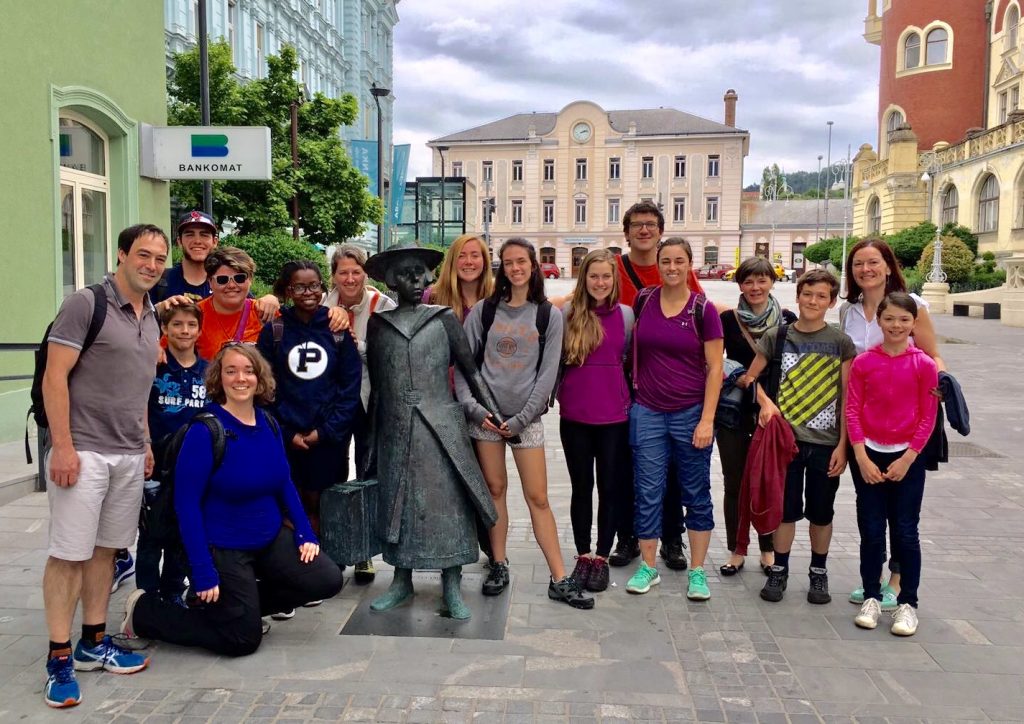
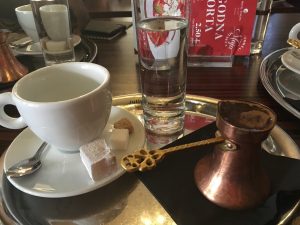 After an hour-long drive we met our hosts at in the cafe at Hotel Evropa where many of us drank the famous Turkish coffee before headingto Pokrajinski Muzej. At the museum, we toured the castle/palace where the counts of Celje used to live. The most recent castle was built on top of an old Roman road and fortifications of the city of Celeia. During Roman rule, the structure was used as barracks and for military protection. Signs of Roman heating and sewage systems are on display in a below-ground exhibition of Roman ruins found and left in situ. At one point our tour group was standing in what had been the moat. As proof, the castle ruins show three ground floors because each time it was rebuilt (three distinct times after conquests by such enemies as Attila the Hun) the ground floor was built higher and higher because of the rising water level. (After our museum visit our hosts showed us the new Celje information center, where more Roman ruins are displayed in situ in the city center. They were discovered in 2015 when the town was upgrading a pedestrian area.)
After an hour-long drive we met our hosts at in the cafe at Hotel Evropa where many of us drank the famous Turkish coffee before headingto Pokrajinski Muzej. At the museum, we toured the castle/palace where the counts of Celje used to live. The most recent castle was built on top of an old Roman road and fortifications of the city of Celeia. During Roman rule, the structure was used as barracks and for military protection. Signs of Roman heating and sewage systems are on display in a below-ground exhibition of Roman ruins found and left in situ. At one point our tour group was standing in what had been the moat. As proof, the castle ruins show three ground floors because each time it was rebuilt (three distinct times after conquests by such enemies as Attila the Hun) the ground floor was built higher and higher because of the rising water level. (After our museum visit our hosts showed us the new Celje information center, where more Roman ruins are displayed in situ in the city center. They were discovered in 2015 when the town was upgrading a pedestrian area.)
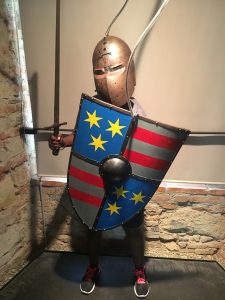 During medieval times, the castle and its walls sported marble representative of the Roman era. Marble statues were displayed in the house as a form of decoration. During the tour, we each got to put on the helmet of a knight, which was heavy, and hold a shield and sword. Overall, there were 18 counts of Celje, and their skulls (carbon dated for identification purposes) can be found in this museum in an eerie gallery.
During medieval times, the castle and its walls sported marble representative of the Roman era. Marble statues were displayed in the house as a form of decoration. During the tour, we each got to put on the helmet of a knight, which was heavy, and hold a shield and sword. Overall, there were 18 counts of Celje, and their skulls (carbon dated for identification purposes) can be found in this museum in an eerie gallery.
This, however, was not the only castle owned by the counts of Celje. They owned 250 other castles, and we got to visit another one, the Celje castle. It’s more of a ruin–a fortified castle more than a palace–and you can see the whole town from the top of the Frederick Tower. It is an amazing view. During our exploration of the Celje castle, we were told two stories about the counts: one of Frederick and Veronica, and the other of Barbara and the end of the line of the counts of Celje.
Barbara, daughter of one of the counts, was queen of three countries. She was married to the Roman emperor Sigsimund of Luxembourg at the age of thirteen and thus became the Empress. Later, she was also crowned queen of Bohemia, Germany, and Hungary. She gave birth to only one child, Elizabeth, who in turn gave birth to children whose descendants can be traced up to the Queen of England. Barbara showcased high intelligence as she spoke seven languages and managed different estates; she once lent money to her husband when he was in trouble.
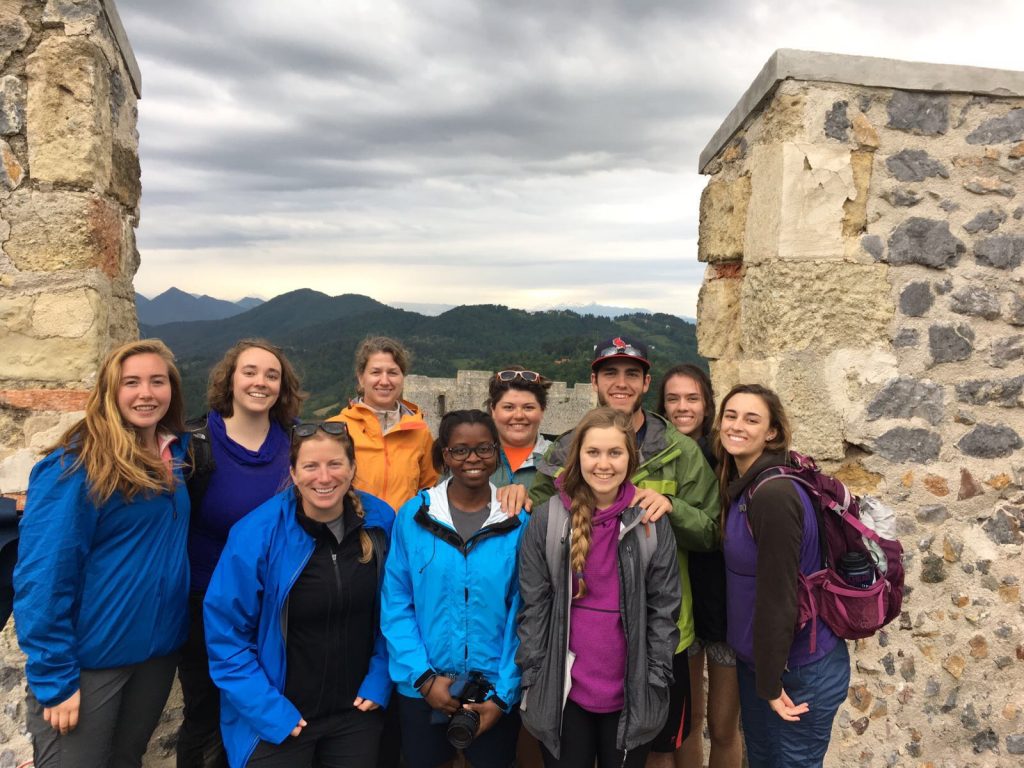 Now the story of Frederick and Veronika mirrors that of Romeo and Juliet to a certain degree. Frederick was a count, child of Herman II, while Veronika was just a lowly peasant. After the death of his wife, Frederick wanted to be with Veronica but his father disapproved. Veronika got accused of witchcraft and was brought in for trial. After her escape, she lived with monks for a while and then later was captured and drowned by Herman II’s army.
Now the story of Frederick and Veronika mirrors that of Romeo and Juliet to a certain degree. Frederick was a count, child of Herman II, while Veronika was just a lowly peasant. After the death of his wife, Frederick wanted to be with Veronica but his father disapproved. Veronika got accused of witchcraft and was brought in for trial. After her escape, she lived with monks for a while and then later was captured and drowned by Herman II’s army.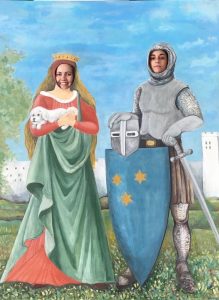
The last count, Ulrich II was killed by Hungarians. He wanted to rule and made a lot contributions to the empire, but since the Hungarians didn’t want him to, he was lured to Belgrade and killed. His funeral happened on November 8 in 1556; his shield was broken in half and the rule of the counts of Celje ended. All their property was seized by the Habsburg empire–the two families had signed an agreement that if one family’s line died out, the other would inherit the other’s lands and possessions–who in turn neglected the castles and tried to erase traces of the counts from the castle.
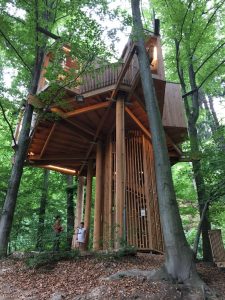 The highlight of the day for me was the tree house in the city forest. After a twenty-minute walk from lunch followed by a twenty-minute hike up hill, we arrived on the site of the tree house. It is a beautiful place in the middle of the woods of Douglas-fir trees. We ate ice cream brought by our hosts and listened to Erazum and Oskar play clarinet and guitar. Brooke played guitar, and then Oskar showed us some break dance moves.
The highlight of the day for me was the tree house in the city forest. After a twenty-minute walk from lunch followed by a twenty-minute hike up hill, we arrived on the site of the tree house. It is a beautiful place in the middle of the woods of Douglas-fir trees. We ate ice cream brought by our hosts and listened to Erazum and Oskar play clarinet and guitar. Brooke played guitar, and then Oskar showed us some break dance moves.
The day concluded with a traditional Slovenian meal at Francl, a restaurant locals take pride in, and another hour-long drive panicking about event maps due at midnight.
All in all, it was a day of learning and fun, and we are grateful Bostjan, Jason, and their families were able to share it with us.
~Genie
Genie Nyiramana is a junior majoring in computer science. She loves photography and is capturing lots of images around Slovenia. Her cultural studies subject is Slovenian Istria, including Piran.

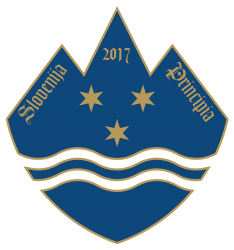

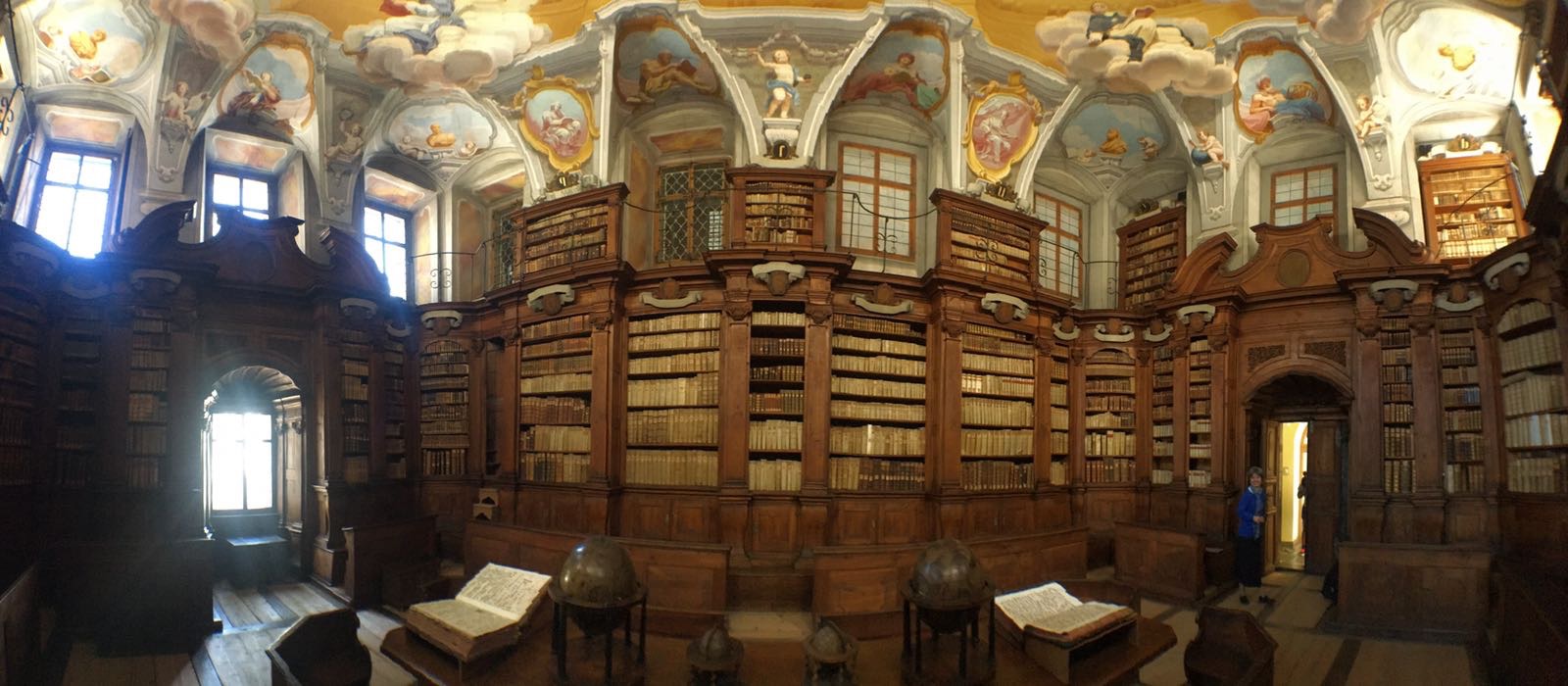
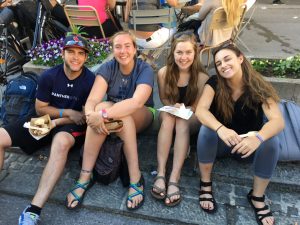 The guy in the restaurant greeted us in Slovene, and we responded in the limited Slovene that we’ve learned before letting him know that we speak English. He hesitantly responded by telling us that he knew very little English. While this didn’t seem convenient, we agreed that we would just find a way to communicate and get our cevappi.
The guy in the restaurant greeted us in Slovene, and we responded in the limited Slovene that we’ve learned before letting him know that we speak English. He hesitantly responded by telling us that he knew very little English. While this didn’t seem convenient, we agreed that we would just find a way to communicate and get our cevappi.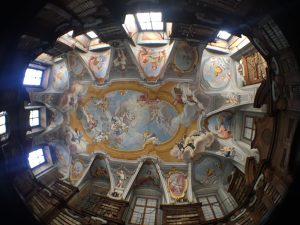 library that we visited. I don’t remember hearing the name, but I zone out a lot. (The blog editor knows it’s the Semenska Knijzica, a Baroque library that at one time held a 1:1ratio of books to citizens of Ljbuljana.) I’m not kidding when I say that this was the coolest library I’ve ever stepped foot in. Books are already cool, but I’m telling you that this place made books seem cool
library that we visited. I don’t remember hearing the name, but I zone out a lot. (The blog editor knows it’s the Semenska Knijzica, a Baroque library that at one time held a 1:1ratio of books to citizens of Ljbuljana.) I’m not kidding when I say that this was the coolest library I’ve ever stepped foot in. Books are already cool, but I’m telling you that this place made books seem cool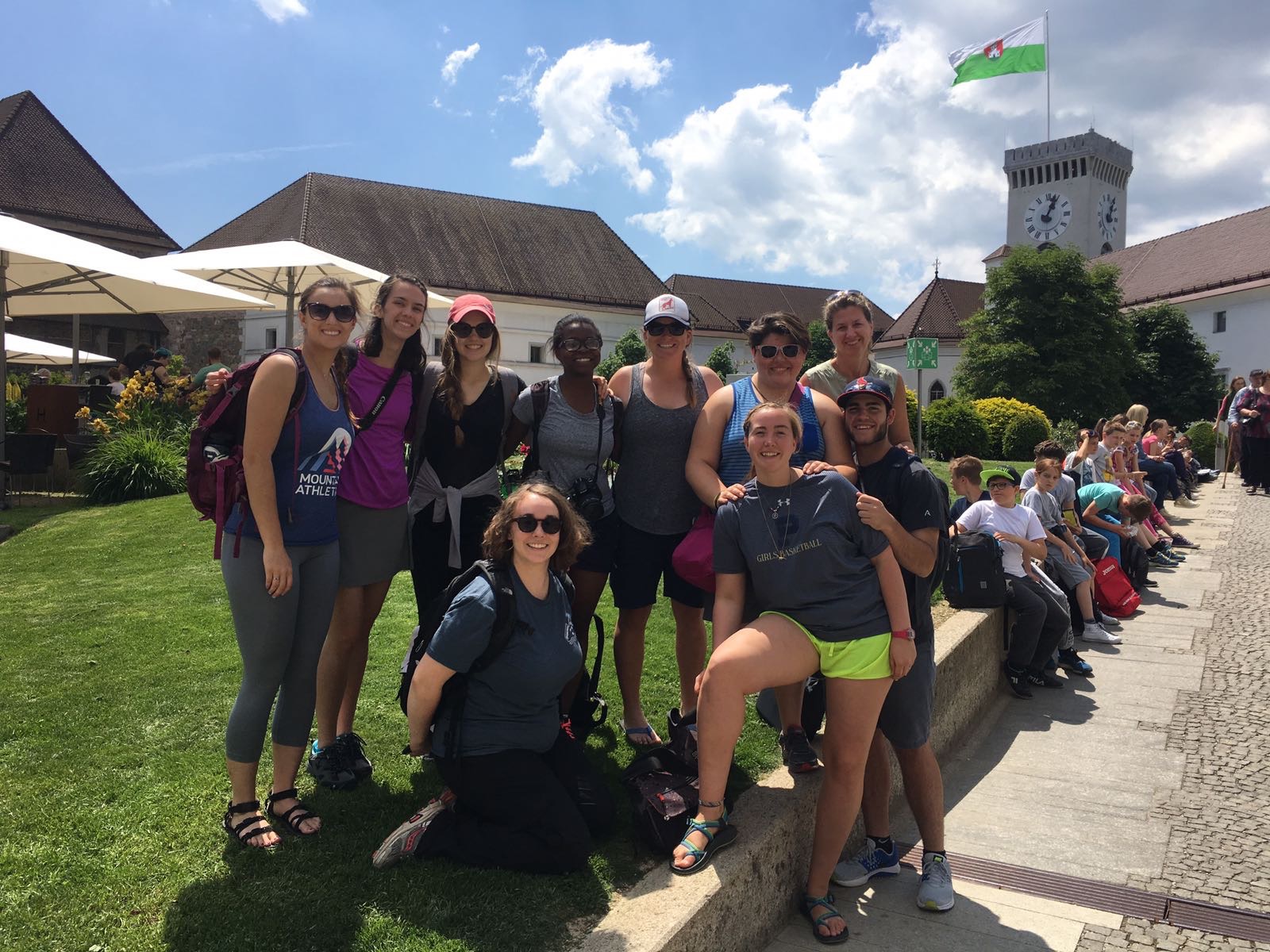 While the castle was more touristy than I was expecting—there were glossy signs on every door, railings and glass windows all over the place, just stuff like that—the view from the top tower was special. As the highest point in a very not tall city, the view from the tower allows you to see one-third of the entire country of Slovenia. Landscape and rooftops stretch on for miles and miles, and there’s even a faint glimpse of Austria to the northwest and Croatia to the southwest. On a clear day you can see Mount Triglav, the country’s highest peak.
While the castle was more touristy than I was expecting—there were glossy signs on every door, railings and glass windows all over the place, just stuff like that—the view from the top tower was special. As the highest point in a very not tall city, the view from the tower allows you to see one-third of the entire country of Slovenia. Landscape and rooftops stretch on for miles and miles, and there’s even a faint glimpse of Austria to the northwest and Croatia to the southwest. On a clear day you can see Mount Triglav, the country’s highest peak.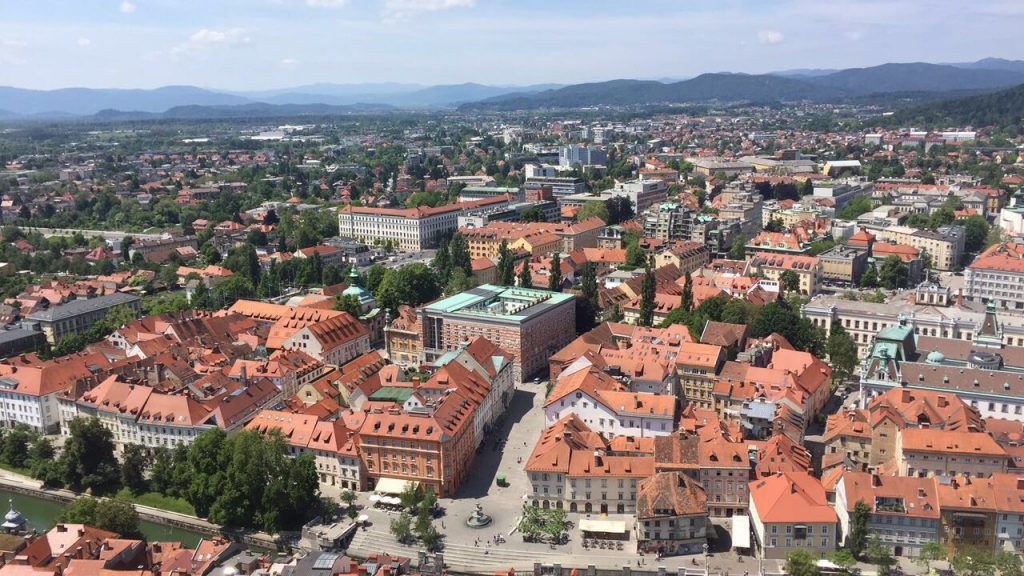
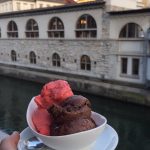 I don’t think anyone chose to eat a meal that wasn’t at the Odprta Kuhna (Open Kitchen). My two meals consisted of filet mignon and potatoes (lunch), roast pork and potatoes (dinner), and double chocolate strawberry gelato (dessert) across the river at Kakao.
I don’t think anyone chose to eat a meal that wasn’t at the Odprta Kuhna (Open Kitchen). My two meals consisted of filet mignon and potatoes (lunch), roast pork and potatoes (dinner), and double chocolate strawberry gelato (dessert) across the river at Kakao.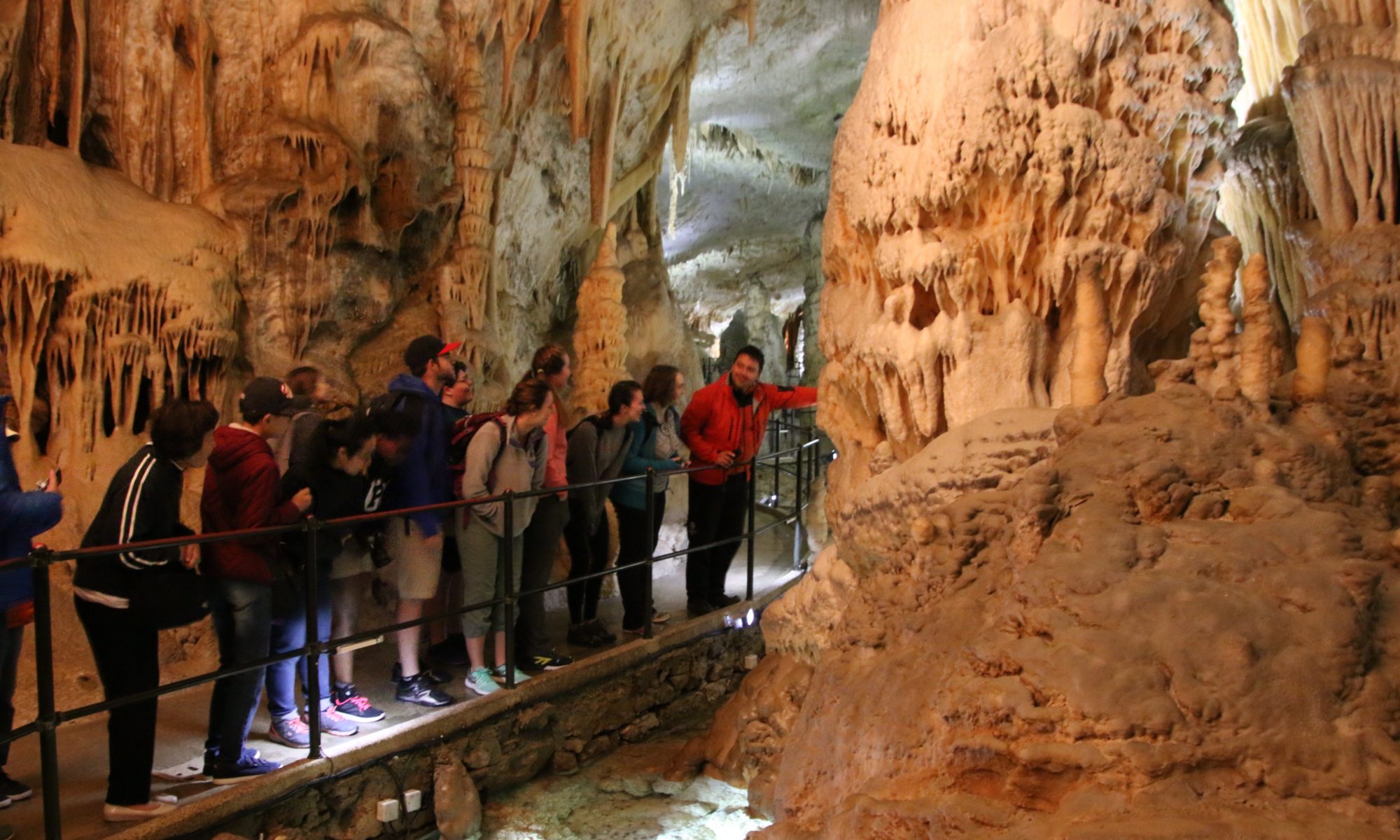
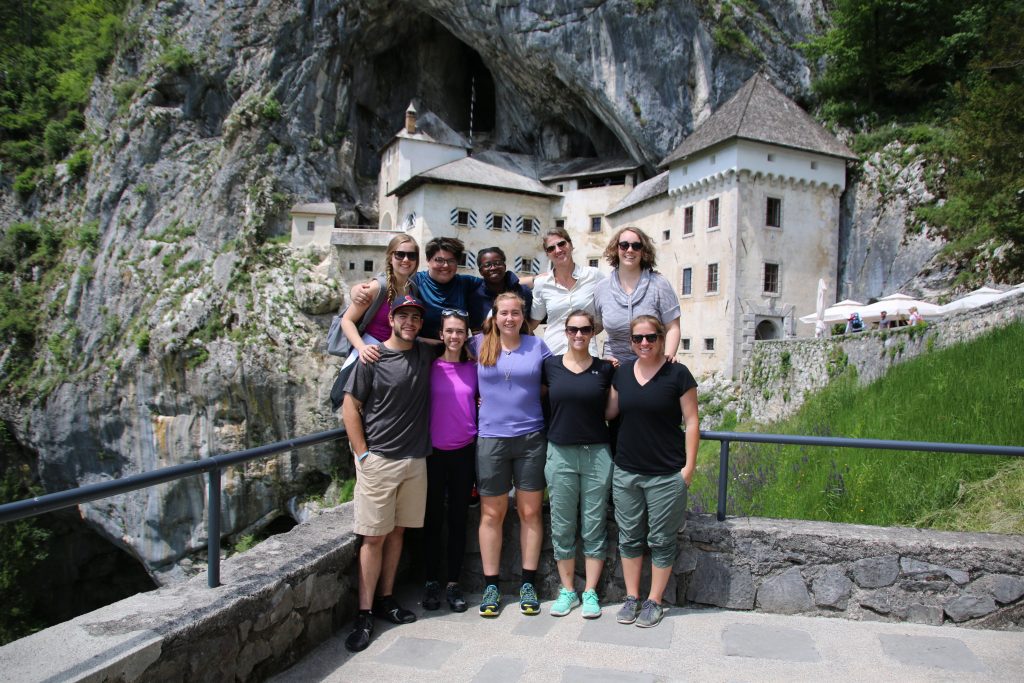 Next we took a 20 minute drive to Predjama Castle. This incredible castle is situated inside a cave! Once inside, you can see how the builders used the natural rock as the back wall of the castle and how effortlessly the manmade walls connect to the natural rock. We also learned about some of the people who lived inside the castle. The most famous owner, Erasmus (Erazem), holed up in the castle for over a year to avoid the army that awaited him outside. He was able to send servants out a secret passageway to get supplies. Ultimately he was betrayed by one of his servants who, when Erasmus was on the toilet, signaled to the army outside using a candle. The army then shot a cannon into the bathroom, causing it to collapse and killing Erasmus. The castle itself has an incredible view of the valley and provided a unique cultural and historical experience for us all!
Next we took a 20 minute drive to Predjama Castle. This incredible castle is situated inside a cave! Once inside, you can see how the builders used the natural rock as the back wall of the castle and how effortlessly the manmade walls connect to the natural rock. We also learned about some of the people who lived inside the castle. The most famous owner, Erasmus (Erazem), holed up in the castle for over a year to avoid the army that awaited him outside. He was able to send servants out a secret passageway to get supplies. Ultimately he was betrayed by one of his servants who, when Erasmus was on the toilet, signaled to the army outside using a candle. The army then shot a cannon into the bathroom, causing it to collapse and killing Erasmus. The castle itself has an incredible view of the valley and provided a unique cultural and historical experience for us all!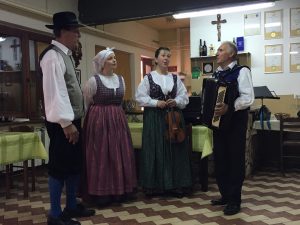 We were also greeted traditionally by being given a piece of homemade bread which we then dipped in salt and ate. It was so fun to walk in while traditional music was being played for us live. Accordion, fiddle, and clarinet. We then sat down and were given more bread, water, and fresh apple juice! We continued to eat cabbage soup (which tasted like sauerkraut), homemade mashed potatoes, sausage, and porks slices from their family-owned pigs while the live music continued.
We were also greeted traditionally by being given a piece of homemade bread which we then dipped in salt and ate. It was so fun to walk in while traditional music was being played for us live. Accordion, fiddle, and clarinet. We then sat down and were given more bread, water, and fresh apple juice! We continued to eat cabbage soup (which tasted like sauerkraut), homemade mashed potatoes, sausage, and porks slices from their family-owned pigs while the live music continued.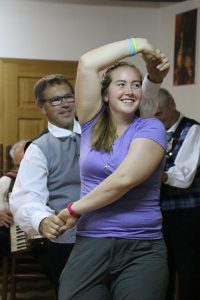 The Slovenes then began to perform traditional dances for us. It was so fun to hear them sing and watch them dance! Once they finished, a man came up to me and asked me to dance! I was taken for a spin, or I should say many, as I was led through one of the traditional dances. Almost all of us danced with one of the individuals we met and we all had a great time! I was sad to leave the festivities, but beyond grateful for the experience. It was a day I won’t soon forget and a memory I will keep forever!
The Slovenes then began to perform traditional dances for us. It was so fun to hear them sing and watch them dance! Once they finished, a man came up to me and asked me to dance! I was taken for a spin, or I should say many, as I was led through one of the traditional dances. Almost all of us danced with one of the individuals we met and we all had a great time! I was sad to leave the festivities, but beyond grateful for the experience. It was a day I won’t soon forget and a memory I will keep forever! It is now a youth hostel where each space serves a purpose, whether for function, aesthetic appeal, or historical evidence. This unconventional buildingnot only functions as a youth hostel, but also as a museum, art gallery, concert hall, and café. Our tour guide (and accomplished architect) Janko Rožic thoroughly described the significance of objects from the front door (which represents a map of the building’s footprint) to the courtyard where the prisoners walked and even the hostel bedrooms which possess their own unique style, each designed by different artists. Janko was key among the artists who transformed the prison into what it is today, located in the alternative culture Metelkova area of Ljubljana.
It is now a youth hostel where each space serves a purpose, whether for function, aesthetic appeal, or historical evidence. This unconventional buildingnot only functions as a youth hostel, but also as a museum, art gallery, concert hall, and café. Our tour guide (and accomplished architect) Janko Rožic thoroughly described the significance of objects from the front door (which represents a map of the building’s footprint) to the courtyard where the prisoners walked and even the hostel bedrooms which possess their own unique style, each designed by different artists. Janko was key among the artists who transformed the prison into what it is today, located in the alternative culture Metelkova area of Ljubljana.
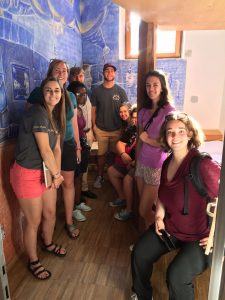 The floor in the main hallway, located on the second level, was designed to be high towards doors on each side and dip down in the center. When exiting a room, a gravitational boost results, creating a light feeling and sense of relief. This represents how the prisoners felt when they left their tiny cells and, ultimately, when they were released from confinement: lighter.
The floor in the main hallway, located on the second level, was designed to be high towards doors on each side and dip down in the center. When exiting a room, a gravitational boost results, creating a light feeling and sense of relief. This represents how the prisoners felt when they left their tiny cells and, ultimately, when they were released from confinement: lighter.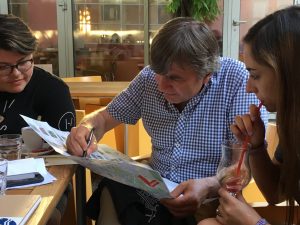
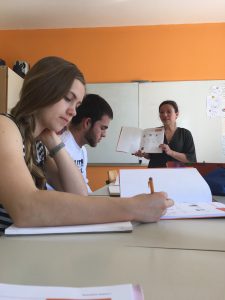 made our 20-minute walk to school. The city was busy with drivers, bicyclists, and pedestrians, but there was a calm to the movement. Everyone knew where to go and how to get there. There did not seem to be any unnecessary chitchat, and most people kept to themselves. As we neared the building, it was clear our group was eager to learn more about the unique language of Slovenian. We were greeted by our wonderful teachers, Anja and Nina, and the lesson soon began.
made our 20-minute walk to school. The city was busy with drivers, bicyclists, and pedestrians, but there was a calm to the movement. Everyone knew where to go and how to get there. There did not seem to be any unnecessary chitchat, and most people kept to themselves. As we neared the building, it was clear our group was eager to learn more about the unique language of Slovenian. We were greeted by our wonderful teachers, Anja and Nina, and the lesson soon began. We went through several activities, and when the 90 minutes were up, we were all surprised at how quickly it flew by. Even moreso, we all were anxiously awaiting the day to follow in which we could practice our new vocabulary.
We went through several activities, and when the 90 minutes were up, we were all surprised at how quickly it flew by. Even moreso, we all were anxiously awaiting the day to follow in which we could practice our new vocabulary.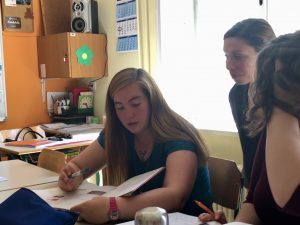 pairs for lunch, the group decided to stick together and go to the highly recommended Cantina Mexicana. Some brave souls chose to order their meals in broken Slovene, and the waiter patiently listened and carefully watched where we pointed on the menu.
pairs for lunch, the group decided to stick together and go to the highly recommended Cantina Mexicana. Some brave souls chose to order their meals in broken Slovene, and the waiter patiently listened and carefully watched where we pointed on the menu.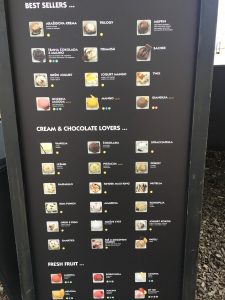 and were ready for a nap. Some plates looked as if the food had not even been touched as to-go boxes were delivered to our tables. It has become very clear to each of us that Slovenians make sure you have had enough to eat and do not allow a plate to leave the kitchen if not every inch has at least a morsel of food.
and were ready for a nap. Some plates looked as if the food had not even been touched as to-go boxes were delivered to our tables. It has become very clear to each of us that Slovenians make sure you have had enough to eat and do not allow a plate to leave the kitchen if not every inch has at least a morsel of food. The 30-minute drive from the airport to our hotel was nothing short of surreal. After months of soaking up cultural facts and historical context, we were finally looking out across the lush fields and quaint buildings of Slovenia.
The 30-minute drive from the airport to our hotel was nothing short of surreal. After months of soaking up cultural facts and historical context, we were finally looking out across the lush fields and quaint buildings of Slovenia.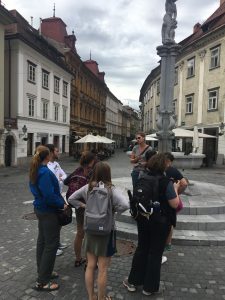
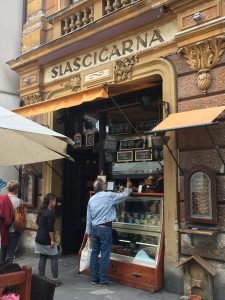
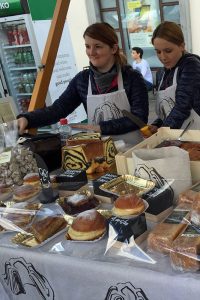 Potica? Well, one breakfast item my mom picked up at Heinen’s market was poppy potica, which we pronounced “pa-ti-ka.” I liked it. The way the cakey bread was rolled up with a sweet poppyseed layer in a way that looked like a giant squashed Ho-Ho was one selling point. Plus, it tasted good. But after I went to college and moved away, I never saw it again. And I didn’t think about it again until 2012 when I stumbled across it in a bakery in Dubrovnik, Croatia. By then I did know a little about the Slovenians in Cleveland. (For those who don’t know, both Slovenia and Croatia, neighbors in Central Europe, were states in the former Yugoslavia. They share some cultural heritage, including food, but each has a quite distinct culture.)
Potica? Well, one breakfast item my mom picked up at Heinen’s market was poppy potica, which we pronounced “pa-ti-ka.” I liked it. The way the cakey bread was rolled up with a sweet poppyseed layer in a way that looked like a giant squashed Ho-Ho was one selling point. Plus, it tasted good. But after I went to college and moved away, I never saw it again. And I didn’t think about it again until 2012 when I stumbled across it in a bakery in Dubrovnik, Croatia. By then I did know a little about the Slovenians in Cleveland. (For those who don’t know, both Slovenia and Croatia, neighbors in Central Europe, were states in the former Yugoslavia. They share some cultural heritage, including food, but each has a quite distinct culture.)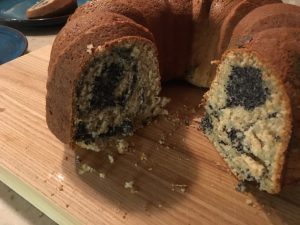 So on this trip to Cleveland, craving some potica, my student and I visited a new downtown location of Heinen’s where I picked up a $14 loaf of Grandma Ann’s Poppy Seed Bread. While I was a little disappointed that it was not Babica Ana’s Makova Potica, it satisfied my craving and will hopefully carry me back to Slovenia in May.
So on this trip to Cleveland, craving some potica, my student and I visited a new downtown location of Heinen’s where I picked up a $14 loaf of Grandma Ann’s Poppy Seed Bread. While I was a little disappointed that it was not Babica Ana’s Makova Potica, it satisfied my craving and will hopefully carry me back to Slovenia in May.